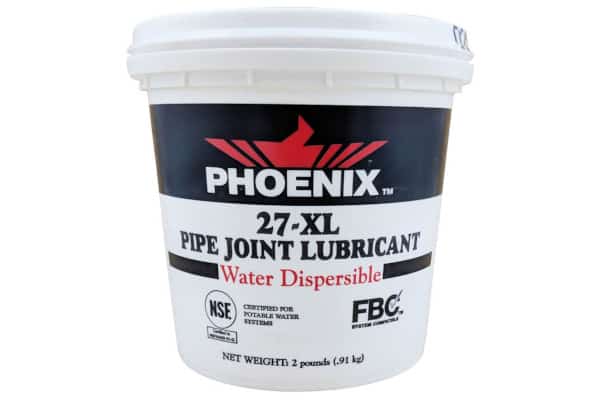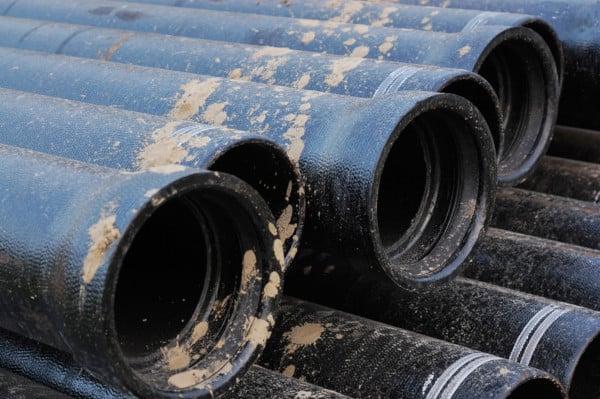Pipe joint lubricant streamlines the fitting of push-on and mechanical joints
Some innovations have made joining pipes significantly easier. From grooved couplings that remove welding from the pipefitter’s equation to adhesives that chemically join plastic pipes, installers can attach a wider variety of pipes in less and less time. Pipe joint lubricant is another such innovation.
In this article, we take a close look at pipe joint lubricant—explaining what it does, when it’s used, and how lubricants vary across brands. We also look at safety issues surrounding the use of pipe joint lubricant, focusing directly on safety data sheets (SDSs) and material safety data sheets (MSDSs) for leading pipe joint lubricants such as Phoenix 27 XL, Phoenix 27 A, and ProSelect.
If you’ve stumbled across this article while looking for some pipe joint lubricant, click here to look at our selection.
Pipe joint lubricants work with specific joints and gaskets to connect pipes and fittings with little effort
Pipe joint lubricant simplifies the process of joining pipes that connect with specific types of fittings. These lubricants work with a wide variety of pipe, including copper, steel, plastic, iron, and more. It’s typically applied to gaskets—often made from synthetic rubber or plastic—and to pipe ends being pushed or mechanically pulled into those gaskets.
There’s no one right way to join all pipes. Flanges hold pipes together with perforated discs and bolts. Grooved couplings seal two abutted pipes using a metal housing and gaskets. Other pipes simply slide into a short, slightly larger section of pipe and bond using welds or adhesives. But often, pipe joint lubricant facilitates the installation of two types of joints: push-on and mechanical.
Push-on joints—the most popular type for iron pipe installed underground—feature a rubber gasket placed inside a groove. Installers can connect pipes with push-on joints by pushing one pipe inside the beveled end of another, as shown in the video below:
In mechanical joints, one pipe end inserts into another, using a gasket to form a seal. However, mechanical joints require the tightening of multiple bolts to fully seal. While tightening those bolts is straightforward—and can be accomplished with a standard ratchet wrench—aligning these fittings and tightening the bolts requires more labor than push-on joints. As a result, push-on fittings are favored for connecting underground iron pipes, while mechanical joints are more often found on other fittings, where it may be awkward or impractical to simply press the parts together.

Environmental standards dictate the materials used in pipe joint lubricants
Since the 1970s, the U.S. Environmental Protection Agency (EPA) has recognized a need to limit the use of lead in products serving plumbing systems. Over the decades that followed, the EPA worked with outside organizations to develop rules meant to make drinking water safer. Today, plumbing products that make contact with drinking water systems, including pipe joint lubricants, comply with standards from NSF International (NSF), formerly known as the National Sanitation Foundation.
Products made for use with water treatment or distribution systems in North America must comply with NSF/ANSI/CAN 61: Drinking Water System Components – Health Effects. This standard seeks to limit the ill effects of various products that contact drinking water. It restricts the level of lead in those materials, as well as the level of lead that can leach out of them.
The Safe Drinking Water Act (SDWA) doesn’t require product testing or third-party certification to prove that a product meets lead-limited requirements. However, eight third-party groups have been certified by the American National Standards Institute (ANSI) to formally certify SDWA-compliant products:
- CSA Group
- IAPMO R&T, Inc.
- ICC-ES
- Intertek
- NSF International
- Truesdail
- UL
- WQA

Products that have been certified to NSF 61 may be marked NSF-61-G—a way to indicate that such products have been tested following specific procedures. Those procedures can be found in NSF/ANSI 372: Drinking Water System Components – Lead Content. NSF 372 tells manufacturers how to test for lead content and ensure that select products have a maximum weighted lead content of 0.25%. While not all products need to meet NSF 61-G (or NSF 372), these standards cover a wide range of items, including water treatment units and food service equipment.
Pipe joint lubricants exhibit slight but important variations in environmental, chemical, and other characteristics
ProSelect, Phoenix 27-XL, and Phoenix 27-A brands of pipe joint lubricant contain no petroleum or phosphate, are non-toxic, and don’t support bacterial growth. Further, all three pipe joint lubricants can be applied at temperatures as high as 150 degrees Fahrenheit. However, Phoenix 27-XL has the widest temperature range (as low as negative 10 degrees Fahrenheit) followed by ProSelect (0 degrees) and Phoenix 27-A (10 degrees).
All three products comply with NSF/ANSI 61. But only ProSelect explicitly claims compliance with two environmentally-stringent state laws: California’s Health and Safety Code (California AB-1953) and Vermont’s Lead in Consumer Products Law (Vermont Act 193). Still, other products, including Phoenix 27-XL, comply with these laws through compliance or testing to NSF 61-G or NSF 372. Vermont Act 193 simply requires compliance with NSF 61-G, or NSF 372, while California’s law requires third-party certification to NSF 372.
All three lubricants work on a wide variety of pipe, including cast iron, concrete, plastic, and clay. They won’t deteriorate natural rubber, synthetic rubber, or plastic gaskets. All three types also market themselves as FBC™ System Compatible. That means they’ve been tested and have few or no negative effects on certain types of plastic piping—specifically, those made from chlorinated polyvinyl chloride (CPVC) from the Lubrizol Corporation.
That last part is of particular importance for fire sprinkler systems, which may feature a mix of nonmetallic and steel pipe. NFPA 13: Standard for the Installation of Sprinkler Systems requires that lubricants used in these mixed-pipe systems be chemically compatible with nonmetallic pipe.
From the 2019 edition of NFPA 13
16.3.9.4* When nonmetallic pipe is used in systems utilizing steel pipe, cutting oils and lubricants used for fabrication of the steel piping shall be compatible with the nonmetallic pipe materials in accordance with 16.1.2.

How to install pipe joints with lubricant
Installing pipe joints with lubricant requires a few simple steps and safety precautions:
- Before connecting pipe joints with lubricant, use clean rags and brushes to clean the pipe and gaskets.
- Then, seat the gasket—with the large sealing end of the gasket toward the rear—and press it into the pipe recesses.
- Apply lubricant liberally over the exposed end of the gasket, as well as the spigot end of the pipe and the outer surface of the pipe, as instructed by the manufacturer. Use a cloth, brush, sponge, or glove, leaving no dry spots.
- For mechanical joints, position the pipe end in the socket and tighten the bolts according to the manufacturer’s instructions. For push-on joints, drive the pipe ends together, using a crowbar, bulldozer, or backhoe as needed.
A few precautions should be observed when working with ProSelect, Phoenix 27-XL, or Phoenix 27-A pipe joint lubricant. Wear safety goggles and chemical-resistant gloves to prevent contact with skin, eyes, and clothing. If the lubricant contacts eyes or skin, wash thoroughly. Seek medical attention if irritation persists.
These compounds have a “slight” health hazard severity (1 on a scale of 0 to 4) as classified by the Hazardous Materials Identification System (HMIS). 1 indicates that exposure can cause irritation or minor reversible injury. However, they’re ranked at 0 severity (“minimal”) for flammability and chemical reactivity. These chemicals will not burn when exposed to a temperature of 1,500 degrees Fahrenheit for a period of five minutes, do not react with water, and remain stable even when exposed to fire.
The safety data sheets or SDSs (formerly MSDSs or material safety data sheets) provide the manufacturer’s authoritative insights on the hazards posed by these substances. Click the links below to view the SDS or MSDS for ProSelect, Phoenix 27-A, and Phoenix 27-XL pipe joint lubricants:
Phoenix 27-XL offers the benefits of the hard-to-get Phoenix 27-A pipe joint lubricant
Phoenix 27-A, while better-established than Phoenix 27-XL, is no longer listed for sale online by the manufacturer, JTM products. In November 2011, JTM announced the release of Phoenix 27-XL; by March 2015, JTM had stopped listing Phoenix 27-A for sale. Phoenix 27-XL has similar attributes—it’s non-toxic, petroleum-free, and certified for use in potable water systems—and offers compatibility with a wide range of pipe and gasket materials.

If you’re looking for a great pipe joint lubricant—and a substitute for Proselect or Phoenix 27-A—take a look at QRFS’s supply of Phoenix 27-XL pipe joint lubricant. It’s certified to NSF 61-G for use in potable water systems, has one of the widest temperature ranges available, and offers chemical compatibility with CPVC pipe and fittings from the Lubrizol Corporation.
Click here to browse our selection of pipe joint lubricant.
Questions about pipe joint lubricant? Call us at +1 (888) 361-6662 or email support@qrfs.com.
This blog was originally posted at blog.qrfs.com. If this article helped you find the pipe joint lubricant you needed, check us out at Facebook.com/QuickResponseFireSupply or on Twitter @QuickResponseFS.


